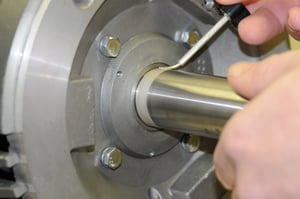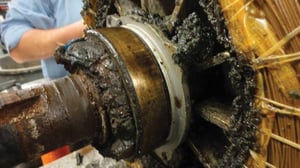Part 12 in a series of questions and answers from our Q&A webinars.
Q1: How critical is it to use colloidal silver paint on the motor shaft?
A1: Using colloidal silver is a best practice for shaft grounding. Because silver is so conductive, it helps electrons (charge) move off of the shaft into the grounding ring's fibers. This improved conductivity lets the shaft voltage come down even lower. With an AEGIS ring and no colloidal silver, the shaft voltage will be between one and five volts. Adding colloidal silver will bring that down to under one volt.
Colloidal silver also helps protect the shaft surface against oxidation and corrosion. It is possible for a nonconductive oxide layer to form on the shaft, which prevents the AEGIS ring from working. Colloidal silver prevents this kind of oxidation.
With that said, an AEGIS ring alone is usually enough to get shaft voltage down to safe levels. With few exceptions, you don't need colloidal silver. The exceptions are given in the best practices from the AEGIS Handbook. Some vertical motors, some larger motors, and all medium voltage motors really do need colloidal silver, along with an appropriate AEGIS ring.
Q2: How often does colloidal silver need to be applied?
A2: We recommend cleaning the shaft and reapplying colloidal silver every six months. If you can do that: Great. If you can't do every six months, because of your production schedule or other factors, then you should do it as often as you can.
Q3: How do you know when a shaft grounding ring needs replacement?

A3: Typically, they don't. Usually if the ring is properly installed, it will be all set. You will get premature wear if the ring is improperly sized or installed such that it loses shaft contact.
Overgreasing can be a big problem. The microfibers can sweep aside small amounts of grease, but they are overwhelmed by large quantities. We have seen too many rings clotted with grease because of some loose cannon with a grease gun and an itchy trigger finger. You definitely want to use a light touch when regreasing motors. Aside from interfering with AEGIS rings, overgreasing causes lots of other problems, too.
But the single best way to tell whether a grounding ring is working is through shaft voltage testing.
Q4: What about monitoring for electrical bearing damage with a discharge pen detector?
A4: We've found that discharge pens are not very accurate with small motors. They do give a more accurate count in motors over 100 hp, but it's not as clear-cut as measuring shaft voltage.
AEGIS Rings also come with a 2-year extended warranty against bearing fluting damage. No other form of protection against VFD-caused bearing damage offers a warranty like this.

![]() To learn more about AEGIS shaft grounding and best practices for electrical bearing protection, sign up for a training. We offer monthly live training webinars, and - pandemic restrictions permitting - we can also visit your facility to review your exact application.
To learn more about AEGIS shaft grounding and best practices for electrical bearing protection, sign up for a training. We offer monthly live training webinars, and - pandemic restrictions permitting - we can also visit your facility to review your exact application.


